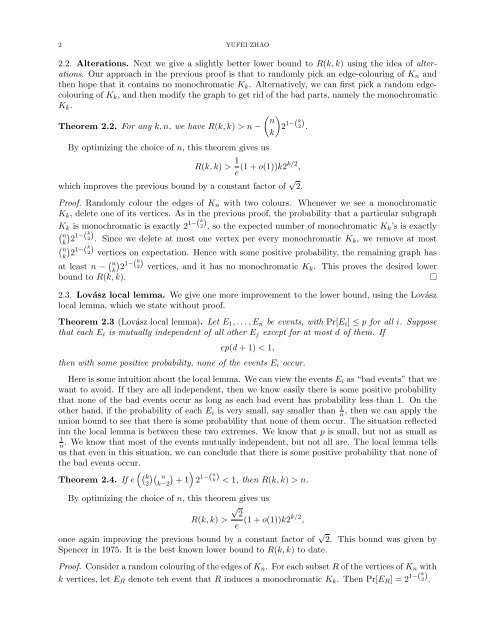PROBABILISTIC METHODS IN COMBINATORICS 1. Introduction ...
PROBABILISTIC METHODS IN COMBINATORICS 1. Introduction ...
PROBABILISTIC METHODS IN COMBINATORICS 1. Introduction ...
You also want an ePaper? Increase the reach of your titles
YUMPU automatically turns print PDFs into web optimized ePapers that Google loves.
2 YUFEI ZHAO<br />
2.2. Alterations. Next we give a slightly better lower bound to R(k, k) using the idea of alterations.<br />
Our approach in the previous proof is that to randomly pick an edge-colouring of K n and<br />
then hope that it contains no monochromatic K k . Alternatively, we can first pick a random edgecolouring<br />
of K k , and then modify the graph to get rid of the bad parts, namely the monochromatic<br />
K k .<br />
( n<br />
Theorem 2.2. For any k, n, we have R(k, k) > n − 2<br />
k)<br />
1−(k 2) .<br />
By optimizing the choice of n, this theorem gives us<br />
R(k, k) > 1 e (1 + o(1))k2k/2 ,<br />
which improves the previous bound by a constant factor of √ 2.<br />
Proof. Randomly colour the edges of K n with two colours. Whenever we see a monochromatic<br />
K k , delete one of its vertices. As in the previous proof, the probability that a particular subgraph<br />
K k is monochromatic is exactly 2 1−(k 2) , so the expected number of monochromatic Kk ’s is exactly<br />
( n<br />
)<br />
k 2<br />
1−( k 2) . Since we delete at most one vertex per every monochromatic Kk , we remove at most<br />
( n<br />
)<br />
k 2<br />
1−( k 2) vertices on expectation. Hence with some positive probability, the remaining graph has<br />
at least n − ( n<br />
k)<br />
2<br />
1−( k 2) vertices, and it has no monochromatic Kk . This proves the desired lower<br />
bound to R(k, k).<br />
□<br />
2.3. Lovász local lemma. We give one more improvement to the lower bound, using the Lovász<br />
local lemma, which we state without proof.<br />
Theorem 2.3 (Lovász local lemma). Let E 1 , . . . , E n be events, with Pr[E i ] ≤ p for all i. Suppose<br />
that each E i is mutually independent of all other E j except for at most d of them. If<br />
ep(d + 1) < 1,<br />
then with some positive probability, none of the events E i occur.<br />
Here is some intuition about the local lemma. We can view the events E i as “bad events” that we<br />
want to avoid. If they are all independent, then we know easily there is some positive probability<br />
that none of the bad events occur as long as each bad event has probability less than <strong>1.</strong> On the<br />
other hand, if the probability of each E i is very small, say smaller than 1 n<br />
, then we can apply the<br />
union bound to see that there is some probability that none of them occur. The situation reflected<br />
inn the local lemma is between these two extremes. We know that p is small, but not as small as<br />
1<br />
n<br />
. We know that most of the events mutually independent, but not all are. The local lemma tells<br />
us that even in this situation, we can conclude that there is some positive probability that none of<br />
the bad events occur.<br />
( (k )(<br />
Theorem 2.4. If e n<br />
) )<br />
2 + 1 2 1−(n k) < 1, then R(k, k) > n.<br />
k−2<br />
By optimizing the choice of n, this theorem gives us<br />
√<br />
2<br />
R(k, k) ><br />
e (1 + o(1))k2k/2 ,<br />
once again improving the previous bound by a constant factor of √ 2. This bound was given by<br />
Spencer in 1975. It is the best known lower bound to R(k, k) to date.<br />
Proof. Consider a random colouring of the edges of K n . For each subset R of the vertices of K n with<br />
k vertices, let E R denote teh event that R induces a monochromatic K k . Then Pr[E R ] = 2 1−(k 2) .
















